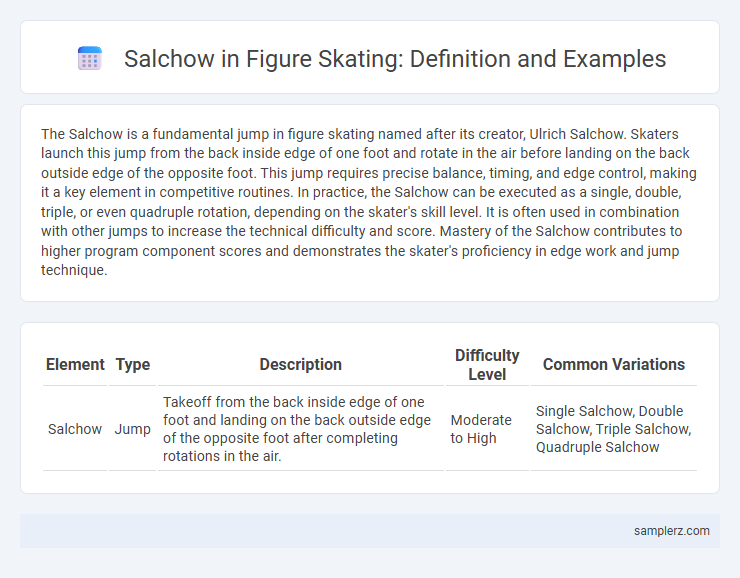The Salchow is a fundamental jump in figure skating named after its creator, Ulrich Salchow. Skaters launch this jump from the back inside edge of one foot and rotate in the air before landing on the back outside edge of the opposite foot. This jump requires precise balance, timing, and edge control, making it a key element in competitive routines. In practice, the Salchow can be executed as a single, double, triple, or even quadruple rotation, depending on the skater's skill level. It is often used in combination with other jumps to increase the technical difficulty and score. Mastery of the Salchow contributes to higher program component scores and demonstrates the skater's proficiency in edge work and jump technique.
Table of Comparison
| Element | Type | Description | Difficulty Level | Common Variations |
|---|---|---|---|---|
| Salchow | Jump | Takeoff from the back inside edge of one foot and landing on the back outside edge of the opposite foot after completing rotations in the air. | Moderate to High | Single Salchow, Double Salchow, Triple Salchow, Quadruple Salchow |
Understanding the Salchow Jump in Figure Skating
The Salchow jump in figure skating is an edge jump executed by taking off from the back inside edge of one skate and landing on the back outside edge of the opposite skate. It is named after Ulrich Salchow, who first performed this jump in competition. Mastery of the Salchow requires precise balance, rotation speed, and control to achieve the necessary height and clean landing.
History and Evolution of the Salchow
The Salchow jump, first introduced by Swedish figure skater Ulrich Salchow in 1909, revolutionized competitive figure skating by adding a new athletic element to routines. Over the decades, the technique evolved from single to double, triple, and even quadruple rotations, showcasing advances in skater strength and training methods. Modern figure skaters like Evgeni Plushenko and Yuzuru Hanyu have pushed the boundaries of the Salchow, elevating it to a cornerstone of jump combinations in international competitions.
Key Techniques for Executing a Salchow
The Salchow jump in figure skating requires precise edge control, starting from a back inside edge takeoff on the left foot for counterclockwise rotation. Skaters must achieve strong rotational momentum by swinging the free leg and arms while maintaining a tight core to execute multiple rotations in the air. Landing requires a smooth transition onto the right back outside edge with a controlled upper body posture to ensure stability and flow into the next movement.
Famous Skaters Known for Their Salchow
Midori Ito, the first woman to land a triple Salchow in competition, remains a legendary figure in figure skating for her technical prowess. Yuzuru Hanyu consistently executes the Salchow with exceptional speed and height, earning multiple Olympic gold medals. Surya Bonaly, known for her unique backflip and powerful Salchow jumps, pushed the boundaries of athleticism in the sport.
Step-by-Step Breakdown of a Salchow Jump
The Salchow jump in figure skating begins with the skater executing a backward inside edge takeoff from the back inside edge of one foot. After gaining momentum, the skater rotates in the air, completing one or more full rotations depending on the skill level, before landing on the back outside edge of the opposite foot. Proper body control, edge precision, and timing are critical to achieving successful takeoff, rotation, and clean landing phases in the Salchow jump.
Common Mistakes When Performing a Salchow
Common mistakes when performing a Salchow in figure skating include improper takeoff edge, often using the outside edge instead of the correct inside edge, which leads to loss of control and balance. Another frequent error is insufficient rotation in the air, causing under-rotated jumps and possible stumbles on landing. Skaters may also lean too far forward or backward, disrupting the jump's alignment and resulting in unstable landings or falls.
Scoring Criteria for the Salchow in Competitions
The Salchow jump in figure skating is evaluated based on takeoff from the back inside edge of one foot and landing on the back outside edge of the opposite foot, with emphasis on height, rotation speed, and clean landing. Judges score execution by assessing edge quality, stability, and the absence of falls or toe touches, directly impacting the Grade of Execution (GOE) points. Base value varies with rotation count, where quadruple Salchow holds a higher base value compared to triple, influencing the total Technical Element Score (TES) in competition.
Variations: Double, Triple, and Quadruple Salchows
The Salchow jump in figure skating features variations based on rotation counts, including Double, Triple, and Quadruple Salchows, with each increasing in technical difficulty. Double Salchows involve two full rotations, commonly performed by intermediate skaters, while Triple Salchows require three rotations and are standard in competitive routines. Quadruple Salchows, incorporating four rotations, represent elite-level skill and are performed by top male skaters to maximize scoring potential under the ISU judging system.
Training Tips for Mastering the Salchow
Mastering the Salchow requires consistent practice of edge control and takeoff timing on the back inside edge of the skating foot. Focused exercises like off-ice jump drills and repeated on-ice Salchow attempts improve muscle memory and rotational stability. Incorporating balance training and strength conditioning enhances jump height and smooth landing execution in figure skating routines.
Impact of the Salchow on Figure Skating Routines
The Salchow jump revolutionized figure skating routines by introducing a seamless blend of technical difficulty and artistic expression, elevating performance standards. Its inclusion challenges skaters to master precise edge control and airborne rotation, significantly influencing choreography and scoring criteria in competitions. The Salchow remains a benchmark for evaluating athleticism and grace, shaping the evolution of modern figure skating programs.

example of salchow in figure skating Infographic
 samplerz.com
samplerz.com